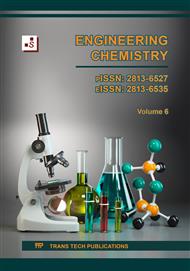[1]
A.P Fews, D. L. Henshaw, High resolution alpha particle spectroscopy using CR-39 plastic track detector, Nuclear Instruments and Methods in Physics Research. 197 (1982) 517–529.
DOI: 10.1016/0167-5087(82)90349-0
Google Scholar
[2]
D. Hermsdorf, M. Hunger, S. Starke, F. Weickert, Measurement of bulk etch rates for poly-allyl-diglycol carbonate (PADC) and cellulose nitrate in a broad range of concentration and temperature of NaOH etching solution, Radiation Measurements. 42 (2007) 1–7.
DOI: 10.1016/j.radmeas.2006.06.009
Google Scholar
[3]
D.S. Manar, A.R. Ali, F.K. Nada, A. El-Taher, Journal of Radiation and Nuclear Applications. 5 (2020) 119–125.
Google Scholar
[4]
M. el Ghazaly, On alpha particle spectroscopy based on the over-etched track length in PADC (CR-39 detector), Radiation Effects and Defects in Solids. 167 (2012) 421–427.
DOI: 10.1080/10420150.2012.678009
Google Scholar
[5]
A. F. Saad, M. Fromm, M. H. Ibraheim, A. A. El-Namrouty, A. M. Nwara, S. A. Kandil, M. S. Dawood, M. S. (2021). Loss of chemical bonds induced by high doses of γ-radiation in a PADC polymer film: The influence of dose and dose rate on radiation chemical yields. Radiation Physics and Chemistry. 187 (2021) 109579.
DOI: 10.1016/j.radphyschem.2021.109579
Google Scholar
[6]
T. Yamauchi, S. Kaifu, Y. Mori, M. Kanasaki, K. Oda, S. Kodaira, T. Konishi, N. Yasuda, R. Barillon, Applicability of the polyimide films as an SSNTD material. Radiation Measurements. 50 (2013) 16–21.
DOI: 10.1016/j.radmeas.2012.04.013
Google Scholar
[7]
K.C.C. Tse, F.M.F. Ng, K.N. Yu, Photo-degradation of PADC by UV radiation at various wavelengths, Polymer Degradation and Stability. 91 (2006) 2380–2388.
DOI: 10.1016/j.polymdegradstab.2006.03.017
Google Scholar
[8]
M. El Ghazaly, H. E. Hassan, Spectroscopic studies on alpha particle-irradiated PADC (CR-39 detector), Results in Physics. 4 (2014) 40-43.
DOI: 10.1016/j.rinp.2014.04.001
Google Scholar
[9]
A.V.E. Bagulya, L.L. Kashkarov, N.S. Konovalova, N.M. Okat'eva, N.Y.G.E. Polukhina, Starkov, N.I, Search for superheavy elements in galactic cosmic rays, JETP letters. 97(2013) 708-719.
DOI: 10.1134/s0021364013120047
Google Scholar
[10]
F.F. Komarov, Nano-and microstructuring of solids by swift heavy ions, Physics-Uspekhi. 60.5 (2017) 435.
DOI: 10.3367/ufne.2016.10.038012
Google Scholar
[11]
V.Alexeev, A.Bagulya, M.Chernyavsky, A. Gippius, L. Goncharova, S.Gorbunov, A.Volkov, Charge spectrum of heavy and superheavy components of galactic cosmic rays, Results of the olimpiya experiment, The Astrophysical Journal. 829.2 (2016) 120.
DOI: 10.3847/0004-637x/829/2/120
Google Scholar
[12]
R. A. Rymzhanov, S. A. Gorbunov, N. Medvedev, A. E. Volkov, Damage along swift heavy ion trajectory, Nuclear Instruments and Methods in Physics Research section B. Beam Interactions with Materials and Atoms. 440 (2019)25-35.
DOI: 10.1016/j.nimb.2018.11.034
Google Scholar
[13]
B. Dörschel, D. Hermsdorf, K. Kadner, Studies of experimentally determined etch-rate ratios in CR-39 for ions of different kinds and energies, Radiation measurements. 35.3 (2002) 183-187.
DOI: 10.1016/s1350-4487(02)00049-5
Google Scholar
[14]
D. Nikezic, K. N. Yu, Formation and growth of tracks in nuclear track materials, Materials Science and Engineering: R: Reports. 46.3-5 (2004)51-123.
DOI: 10.1016/j.mser.2004.07.003
Google Scholar
[15]
S.A. Amin, D.L. Henshaw, Effect of various etching solutions on the response of CR-39 plastic track detector. Nuclear Instruments and Methods in Physics Research. 190.2 (1981) 415-421.
DOI: 10.1016/0029-554x(81)90307-4
Google Scholar


